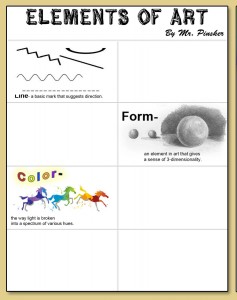The goal of this assignment is to build on your awareness of the existence and application of Elements of Art in artwork by introducing you to all of the terminology. You will learn 15 total Elements of Art and Principles of Design.
You will be learning about the basic Elements of Art and Principles of Design. You will create a reference guide containing definitions and images of these Elements/Principles for use in analyzing your artwork that you encounter and/or produce. The reference guide will take the form of a poster and will include definitions and most importantly, original illustrations. The poster will be 11″ x 17″ and will be created in Adobe Photoshop or Illustrator or combination of both.
Activity: Knowing about the basic Elements of Art and Principles of Design can not only serve as a basis for creating dynamic art, but can also equip you with terminology and techniques for and describing art using descriptive language. First you will read through the Elements of Art Handout. You will then complete the Elements of Art activity worksheet.
You will also be viewing 2 images and filling out a brief worksheet that asks you to describe what you see. The worksheet is designed in a way to prevent the discussion from centering on the subject matter of the artwork, but on the techniques and obvious features of the materials and layout. You will have 3 Elements of Art and 3 Principles of Design written as words (without definitions). There will also be a blank space for you to write in how the 6 total words apply to each of the two images. (See attached worksheet.)
Interpret Definitions: The attached documents (Elements of Art and Elements Fill-In Packet) provide basic examples that represent definitions of each Elements of Art. These documents should be used to help you inspire you to create similar visuals for use in your final posters.
Create an Elements of Art Poster: Using Adobe Photoshop or Illustrator, you will combine your images and text definitions into one posters:
- Create your artwork on an 11″ x 17″(portrait) file in Photoshop at 300 dpi or 11″ x 17″(portrait) file in Illustrator.
- Organize information (your sketches and corresponding definitions of the Elements/Principles) in a visually striking way while creating a poster. By creating the poster, you will gain an understanding of the Elements of Art while simultaneously applying the concepts to your art.
- When creating the poster, you will either scan or recreate digitally, your images to accompany the typed definition of each term. You are encouraged to use the space of the page in a creative way; you are not limited merely to organizing your terms/images into columns or rows, but can explore the space on the page.
- Additionally, you are encouraged to find interesting ways to have your text and images interact.
Assessment
- You will participate in a matching quiz to aid in the retention of Elements/Principles definitions.
- Additionally, you will write a brief (1-2 paragraph) reflection on your poster. This written reflection offers you an opportunity to recall the processes they used to create their work, while giving them a chance to use the vocabulary words correctly. An example of an effective use of vocabulary in a reflection would be: “A line is any mark that suggests direction. I used many different types of lines (straight, thick, squiggly, jagged, etc.) in my poster to show that different lines can be used for different effects.”
- Finally, you will grade your finished posters using the attached self-assessment rubric. You will consider the following criteria: Design/Composition, Craftsmanship, Time/Effort, and Written Reflection when grading yourselves. You will pick the number 10 for exemplary performance in a given category and 5 for ‘needs improvement.’ You will fill out your score in the ‘Student’ column. I will grade your work and write a score in the ‘Teacher’ column.
Supporting information: Elements Fill-In Packet, Element & Principle of Design Activity, and Elements of Art
